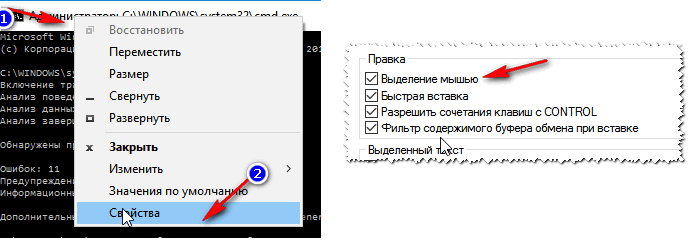Checking laptop battery wear. Assessment of laptop battery wear
This article will discuss methods for determining the degree of wear of a laptop battery. Two methods will be considered and their results compared for the same laptop.
Method 1: Windows Embedded
The advantage of this method is that it does not require the installation of additional programs, and the disadvantage is that it works on versions of Windows 7 and higher. For Windows XP or Vista, use the second method.
Before starting the test, close all running programs, click the "Start" button, find "Command Prompt" in the list of programs, right-click on it and select the "Run as Administrator" command in the context menu.
Type the command in the command prompt window:
Powercfg energy
and press the Enter key.
Wait for the battery testing process to complete (test duration 1 minute).
At the end of the test, you will see something like:

Ignore the errors that will be displayed in the command prompt window. Open the html-file at the path specified in the console by any Internet browser. If this file could not be opened from the "system32" folder, copy it to any other folder and open from there. Scroll down to Battery: Battery Information. Calculate the ratio of the values \u200b\u200b"Last full charge" and "Estimated capacity" on the calculator.
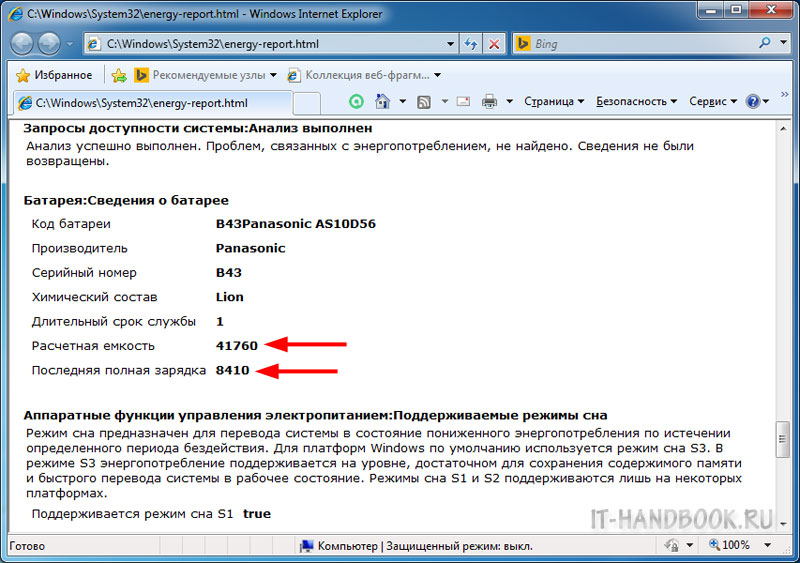
As you can see from the example, the battery capacity is: (8410mAh / 41760mAh) * 100 ≈ 20%, that is, the battery wear is 100% - 20% \u003d 80%. It follows that the laptop owner will soon need to replace the battery.
Method 2: AIDA64 Diagnostic Tool
To determine the status of the laptop battery, you can use the popular application for computer diagnostics - AIDA64. The program is paid, but on the official website you can download a portable, 30-day trial version that does not require installation.
Download, unzip and run the program. In the left pane of the window, go to the "Computer\u003e Power Options" branch.

In the "Battery Properties" section, you can immediately see the degree of battery wear. As you can see, the value within the rounding of the value converges with the value obtained in method 1.
Today, we will analyze another popular and frequently asked question: how to find out the degree of wear of a laptop battery. And immediately we make a reservation - to find out the real wear and tear of the battery will not work in any way - all existing programs allow you to only approximately evaluate these values, although often this will be enough. We will consider two ways.
Determining Wear Using Windows
Open Start, in the search we enter cmd and click on the found cmd.exe file with the right mouse button, choosing Run as administrator. At the command prompt, enter powercfg energy and click Enter.
After a minute, the results of the assessment will appear, but they will not be displayed on the screen, but will be saved in the html file. To search for it, go here:
C: \\ Windows \\ system32 \\ energy-report.html

You probably will not be able to open this file from the system32 folder, so copy it to any other folder, from where we open it using any Internet.
The report is quite voluminous, boldly scroll down and find the section Battery Details.

It will indicate the estimated (passport) capacity of the battery and the capacity at the last full charge. Dividing the last capacity into the passport one can get the remaining resource: in this case, 36% remains.
AIDA64 Battery Wear
To determine the degree of wear, you can use the well-known PC diagnostic program -. Previously, with her help, we, the name, laptop, and so on. Therefore, it is safe - this utility will come in handy to you more than once.
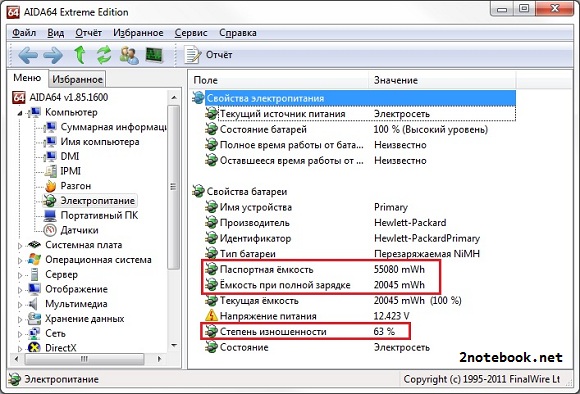
In the program, open the menu Computer - Power supply, and we see the same values \u200b\u200bobtained in the first way using the command line. Here AIDA64 immediately shows the degree of wear - 63%. By the way, this is after 5 years of operation of the laptop, so Windows urgently asks to replace the battery.
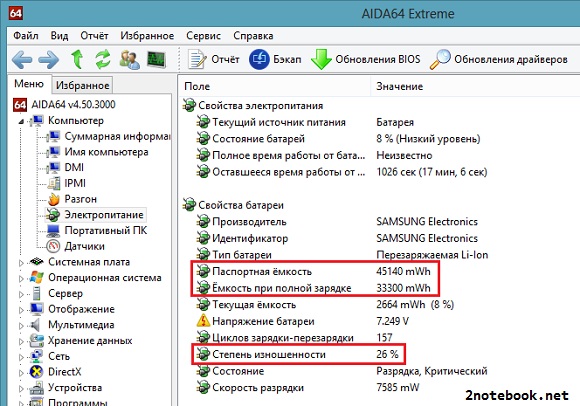
Another example screenshot is a two-year-old Samsung laptop, which was used infrequently. AIDA64 shows 26% deterioration and 157 recharge cycles. These figures also correspond to the theory that in the first two years the battery loses up to 30% of its nominal capacity.
If you decide to replace the battery for the laptop, we recommend reading the story of the specialists of the service center about.
One of the useful features of Windows 8 for owners of laptops / tablets is ability to check battery status (battery) means of the system itself. Using the data obtained, you can find out how the battery is used, how worn it is, whether it needs to be replaced, and to predict its service life. This data can be especially relevant for laptop owners who have drastically reduced battery life, or when buying a used device.
Installed Battery Report ( Battery report) in Windows 8 can be generated using the power management utility ( Power configuration utility).
Run the command line with administrator privileges and run the command:
powercfg / batteryreport
Note. The instructions apply only to devices equipped with a battery. When executing a command on the desktop, an error message appears.
Power Configuration Utility should generate a report file and save it in a file battery_report.htmllocated in the profile of the current user (C: \\ Users \\ (user-name) \\ battery_report.html).
Tip. You can change the directory to which the report is saved with the following command:
powercfg / batteryreport / output "C: \\ SomePath \\ battery_report.html"
Open the resulting report file ( battery-report.html) in any browser and get to know it in more detail.
The first section of the report contains general information about the system and the installed battery (the information is mostly for reference). Much more interesting data is contained in the section. Installedbatteries. For the user there will be such parameters:
- Design capacity –(estimated capacity) is set by the manufacturer and means the maximum capacity of the new battery (measured in milliwatt hours)
- Full charge capacity – (actual capacity) contains information on the current maximum capacity of a fully charged battery
- Chemistry -type of battery, our example uses a lithium-ion battery (LION)
- Cycle count - the number of full cycles of charging / discharging (up to 100%) of the battery, also here the cycles fall when the battery has been discharged to 50%, and recharged.
Note. It is no secret that the number of battery charge / discharge cycles is limited.
Naturally, the closer the values \u200b\u200bin the line Last full charge to the value in the field Estimated capacitythe better, and vice versa. In our example, it can be seen that during operation the battery capacity on the laptop decreased from 38 mWh (mW-hours) to 32 mWh, i.e. Battery wear for almost a year of operation is about 16%.

The report below contains complete information about all previous charging cycles, starting with. When reinstalling the system, all these statistics, of course, are lost.
 Also in the section Batterylifeestimates The powercfg report contains information about the expected life of the system on a charged battery. Of course, you need to understand that the calculation is quite approximate and depends on the profile of the system and the current load.
Also in the section Batterylifeestimates The powercfg report contains information about the expected life of the system on a charged battery. Of course, you need to understand that the calculation is quite approximate and depends on the profile of the system and the current load.

By the way, it is this time that is displayed on the battery icon in the system tray.

In conclusion, here are some simple tips to increase the battery life on a laptop and increase its battery life:
- For NiCad or NiMh batteries, it is recommended that you fully charge / discharge the battery at all times. The fact is that batteries of this type are subject to " memory effect»- a gradual loss of capacity in batteries due to incomplete discharge / charging.
- Lithium-ion batteries (LiIon) are not affected by the “memory effect”, but they are extremely poor at negative temperatures. Therefore, try to use batteries as low as possible at low temperatures.
- LiIon batteries should also sometimes be “trained." To do this, about once a month, carry out a full charge / discharge
- It is not recommended to leave the laptop fully charged when plugged in for a long time, as the battery wears out much faster.
User question ...
Hello. I have been using the laptop for more than 3 years, recently the battery has started to run out quickly - if it had been holding 3-4 hours before, now it’s 1 hour maximum. I myself am inclined to change the battery, but one thing is alarming: suddenly nothing changes after the change, and the reason was different. Tell me, is it possible to assess the degree of battery deterioration programmatically (without service centers and wizards)?
Good day!
In general, on average, a laptop battery (during normal use) lasts about 4-5 years. The fact that your served for 3 years is already not bad. By the way, your fears about changing the battery are not in vain: it is quite possible that the battery itself was not to blame, but a couple of applications that started to “eat up” the entire charge (I’ll say a few words about this in the article).
You can evaluate the degree of deterioration programmatically, but I immediately notice that these data approximate! More accurately, perhaps, it is possible only for specials. equipment. And so, first things first ...
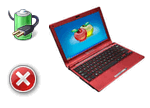
By the way, if your battery does not charge at all, check out the following article:
Assessment of the degree of deterioration of the laptop battery
You can evaluate using special utilities for PC diagnostics, and the command line.
Option number 1 - AIDA 64
There is one indispensable utility for determining the characteristics of a computer - AIDA64 (I mentioned it in this article: in general, I recommend it!).
When you run the utility, open the section Computer / Power . Next, pay attention to several important lines (see the screenshot below):
- Passport capacity - 41440 mWh (this indicator does not change over time, this is the capacity that the manufacturer of your device laid down);
- Capacity at full charge - 41440 mWh;
- The current capacity is 41440 mWh (but this indicator can change. Usually, with the active use of the laptop, the current capacity decreases);
- The degree of deterioration is estimated as a percentage. If the degree of deterioration is more than 30-50%, you can think about changing the battery.

AIDA64 Extreme // Power, Battery Wear
Option 2 - command line
The command line must be run as administrator (this is important!). You can do this in different ways, one of the simplest:
- call task manager - keys Ctrl + Shift + Esc ;
- to press File / Run New Task ;
- introduce CMD, check the box next to the item "Create a task with administrator privileges" click Enter .

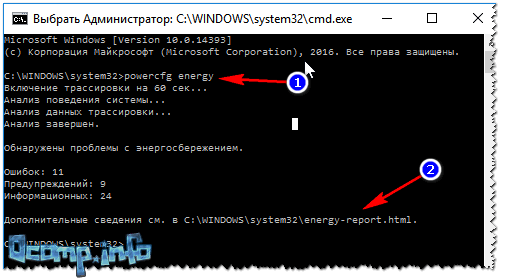
Note!
You can immediately select an address C: \\ WINDOWS \\ system32 \\ energy-report.html and copy it to the browser (I recommend IE or Microfot Edge), but it’s better to open this file using Word.
To select with the mouse on the command line: right-click on the title part of the window and go to properties . Check the box next to "Edit-Mouse Selection" .
Mouse selection on the command line
How to open a report from Powercfg Energy
- Launch the explorer (just open any folder) and paste it into the address bar C: \\ WINDOWS \\ System32,press Enter;
- then we sort the files in order of date (see screen below - date of change) - our file will be on top;
- right click on the file energy-report.html;
- open the tab in the context menu "To open with" and select Word.
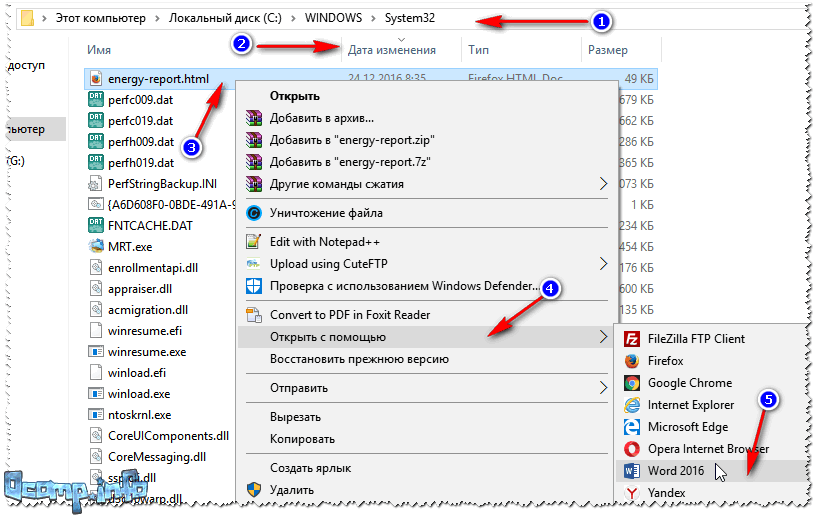
This document will contain a lot of information about your laptop, but we are interested in the section on batteries. There will be a sign - Battery Details (I bring my own a little lower).
Pay attention to two lines here: Estimated capacity and Last full charge . Knowing them, you can assess the degree of deterioration of the battery. For example, in my case: (41440-41440) / 41440 \u003d 0%.
If in the line "Last full charge" I had a different number, say 35000, then the formula would take the form: (41440-35000) / 41440 \u003d 15% (that is, the degree of deterioration would be about 15%).
Another way: special software from manufacturers
Some laptop manufacturers supply their devices with special settings managers, among which there are those that control power, battery power, and monitor its condition.
For example, the screenshot below shows such software from LENOVO. Pay attention to two values: the nameplate capacity, and the capacity when fully charged. By comparing these values, you can quickly understand the status of the battery.
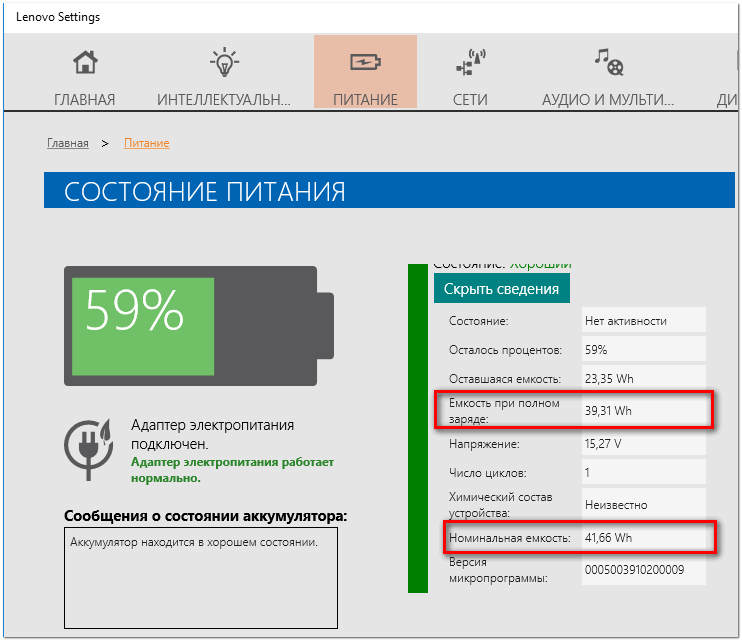
Almost new battery ... And already the degree of deterioration is about 5%!
Find out which apps eat the most energy.
1) In laptops, specials often come with drivers. Utilities from the manufacturer that help assess the degree of battery deterioration, as well as monitor the applications that spend the most charge.
2) If you do not have such a utility, you can use third-party applications, for example, BATExpert . By running the program, you will receive information about the battery of your laptop: the degree of deterioration, the exact time of work from the current charge, its type and temperature, manufacturer, information about charge cycles, etc.
3) In Windows 10 - finding out which apps consume battery power is even easier! First you need to open the START menu and click on Options.

Next, open the section "System", and its subsection - "Battery". Then follow the link "Battery usage specific applications" (see screenshot below).

Actually, then Windows will show you the whole picture (for example, Firefox eats me the most, but this is not surprising 😆). Pay attention to those applications in the list that you hardly use: you need to either not run them (and if they are in Windows startup, uninstall them from there, AIDA64 will help you), or simply delete them.
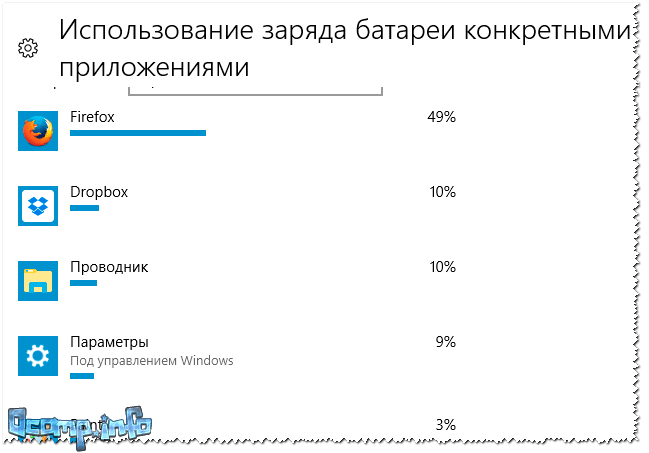
Thus, having assessed the degree of deterioration of the laptop’s battery, as well as those applications that “eat up” the battery charge, we can conclude that it is advisable to replace it. By the way, I also recommend paying attention to the brightness settings of the screen (especially in a dark room - high brightness and contrast not only eat up the battery, but also overwork your eyes -).
That's all for a long battery life!

